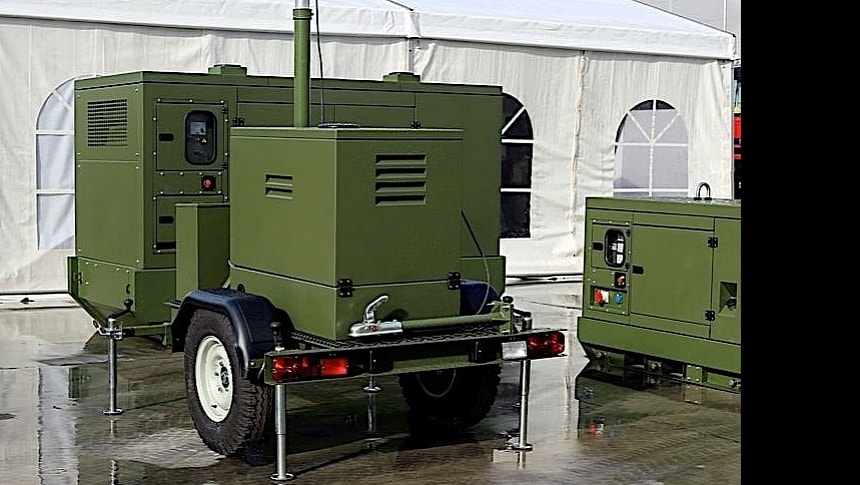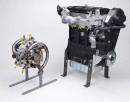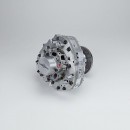Like it or not, the combustion engines that have driven our world forward and sideways for more than a century now are about to leave the scene. Not because they're no longer effective, but because more than a century of using them, combined with other environmentally harmful habits humanity developed over the years, have driven us and our planet to a point where we have no other choice.
But even if they are about to leave the scene, combustion engines will not go extinct in the near future. That's because in some applications, like say field generators deployed for military use, they still can't be matched by alternative means of power generation.
The U.S. Army, for instance, uses a number of field generators to satisfy its electricity needs, one of them being the Advanced Medium Mobile Power Source (AMMPS). That's an umbrella term for a family of rather bulky pieces of equipment that, most of the time, need a lot of effort to be moved into position.
These things work, and the Army will probably use them for many more years to come, but that doesn't mean it's not interested in solutions that might remove some of that bulkiness, making the generators easier to use while at the same time maintaining about the same capabilities.
The Army stumbled upon such a solution not long ago. It's called the XTS-210 heavy-fuel rotary engine, and it popped into the headlines in the fall of 2022, when the Army decided to pump $9 million into the technology.
The engine is the work of a company called LiquidPiston, which made a name for itself by creating something called the High-Efficiency Hybrid Cycle (HEHC) engine design about two decades ago.
HEHC takes the best from several engine types and combines them into a single package. We're talking about a non-Wankle rotary engine with just a very limited number of moving parts, the most important being the rotor and the eccentric shaft.
This configuration delivers three combustion events per rotor revolution, which in turn translates "into tremendous power density." More importantly, these types of engines can run on multiple fuels, and they can be scaled to deliver from one to 1,000 horsepower.
The XTS-210 version that captured the Army's attention is a rotary engine as well and it is about the size of a basketball. It has been designed to work as a two-stroke engine, thus delivering six combustion events per revolution of the rotor.
The 210 in the name refers to its displacement (210cc), but reveals nothing about the power levels it is capable of developing. That would be 25 horsepower, which is tiny for most applications, but more than enough for others, including as a power source for field generators.
It was at the end of last week that LiquidPiston began the testing of the first fully integrated XTS-210 engine. What fully integrated means is that the power unit is now complete, featuring the supercharger, pumps for fuel and oil, and all the required ancillary systems.
The U.S. Army will probably look very closely at how these tests go because the engine has the potential to change the way soldiers get their energy. In a nutshell, the XTS-210 can be installed in a man-portable electric generator with a capacity of 10 kW.
The generator would be 75 percent smaller (it occupies nine cubic feet/0.25 cubic meters of space) and lighter than the AMMPS, making it transportable by hand and removing trucks, trailers, and forklifts from the equation.
Then, the engine runs on pretty much all types of fuel known to man. Although it was technically designed to use jet fuel, it has been successfully tested with gasoline, diesel, propane, and even hydrogen.
The Army generator is just one of the many applications the XTS-210 could be suitable for. Thanks to its size, it's an ideal piece of equipment to be installed inside drones, sea, and land vehicles. Because it's scalable it could also be used as the heart of generators of other power classes as well.
In fact, LiquidPiston is already working on installing the engine inside a hybrid vertical take-off and landing drone. That aircraft is being cooked up for the needs of the U.S. Army as well, following a separate, $1.7 million contract awarded back in 2022 (in all, says the company, the American Department of Defense awarded it over $20 million in contracts).
The details of this application are not public knowledge at the time of writing, but we are told we should expect a demonstration by the end of this year.
We will keep an eye out for further developments regarding the XTS-210 and report back as soon as we know more. After all, it's not every day a new combustion engine comes under the spotlight in this electric motor-driven world of ours.
The U.S. Army, for instance, uses a number of field generators to satisfy its electricity needs, one of them being the Advanced Medium Mobile Power Source (AMMPS). That's an umbrella term for a family of rather bulky pieces of equipment that, most of the time, need a lot of effort to be moved into position.
These things work, and the Army will probably use them for many more years to come, but that doesn't mean it's not interested in solutions that might remove some of that bulkiness, making the generators easier to use while at the same time maintaining about the same capabilities.
The Army stumbled upon such a solution not long ago. It's called the XTS-210 heavy-fuel rotary engine, and it popped into the headlines in the fall of 2022, when the Army decided to pump $9 million into the technology.
The engine is the work of a company called LiquidPiston, which made a name for itself by creating something called the High-Efficiency Hybrid Cycle (HEHC) engine design about two decades ago.
This configuration delivers three combustion events per rotor revolution, which in turn translates "into tremendous power density." More importantly, these types of engines can run on multiple fuels, and they can be scaled to deliver from one to 1,000 horsepower.
The XTS-210 version that captured the Army's attention is a rotary engine as well and it is about the size of a basketball. It has been designed to work as a two-stroke engine, thus delivering six combustion events per revolution of the rotor.
The 210 in the name refers to its displacement (210cc), but reveals nothing about the power levels it is capable of developing. That would be 25 horsepower, which is tiny for most applications, but more than enough for others, including as a power source for field generators.
It was at the end of last week that LiquidPiston began the testing of the first fully integrated XTS-210 engine. What fully integrated means is that the power unit is now complete, featuring the supercharger, pumps for fuel and oil, and all the required ancillary systems.
The U.S. Army will probably look very closely at how these tests go because the engine has the potential to change the way soldiers get their energy. In a nutshell, the XTS-210 can be installed in a man-portable electric generator with a capacity of 10 kW.
Then, the engine runs on pretty much all types of fuel known to man. Although it was technically designed to use jet fuel, it has been successfully tested with gasoline, diesel, propane, and even hydrogen.
The Army generator is just one of the many applications the XTS-210 could be suitable for. Thanks to its size, it's an ideal piece of equipment to be installed inside drones, sea, and land vehicles. Because it's scalable it could also be used as the heart of generators of other power classes as well.
In fact, LiquidPiston is already working on installing the engine inside a hybrid vertical take-off and landing drone. That aircraft is being cooked up for the needs of the U.S. Army as well, following a separate, $1.7 million contract awarded back in 2022 (in all, says the company, the American Department of Defense awarded it over $20 million in contracts).
The details of this application are not public knowledge at the time of writing, but we are told we should expect a demonstration by the end of this year.
We will keep an eye out for further developments regarding the XTS-210 and report back as soon as we know more. After all, it's not every day a new combustion engine comes under the spotlight in this electric motor-driven world of ours.








